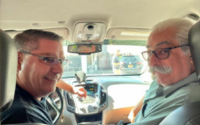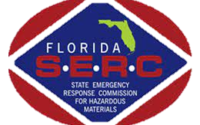The Response
Rob Mercer
Things never happen in a way we anticipate. This fact could very well be called job security for those in Public Safety, as most don’t wake up with a scheduled emergency for the day. Things just happen when and how they do. The same can be said for when we receive those calls, as we simply don’t pick when calls for service occur. Otherwise, the largest hazardous materials response of my 19 year long career would not have occurred while I was over 800 miles away. It did though. At 7:00 PM on the day I arrived in Baltimore Maryland for the IAFC Hazmat Conference, the Department was rolling out to an acid spill on the interstate.
For context, we are a 112-member department running out of six stations and staffing an Airport Station located in South Georgia. As a Regional Response team that receives funding from the State in exchange for responding to other jurisdictions as needed, we cover a very large portion of southwest Georgia. Despite covering hundreds of miles of highway, hundreds of industrial sites, and countless acers of farmland, we run relatively few technician level responses. Despite a lack of frequency, our personnel reacted quickly and efficiently when notified of an incident at an initially unknown location.
As with any hazardous materials response, phone calls started going back and forth. Notifying the Shift Battalion, Fire Chief, State Coordinator, and trying to get more information from the calling agency. We set up a research station with laptops and iPads in the lobby of the hotel and got to work figuring out what we could. It took approximately 45 minutes just to find the incident, and then it was in an entirely different county than previously reported. The driver was told numerous times to notify 911 so we could get to his location that way. I’m not certain he ever did. Once we learned he initially stopped at a rest area along the interstate, we knew his general location and notified the Fire Chief and Emergency Management Agency Director for the suspected county. They initiated a response and located the incident 38 miles North of where it was initially reported to be. Once the product was confirmed, copies of the shipping papers were texted to us along with a series of questions about the product’s properties and concerns.
Personally, I had never heard of fluorosilicic acid (UN: 1778) before this incident, so I didn’t have any of the answers to the questions being directed my way. The more I tried each of the usual computer based technical references and found little to no information, the more anxious I became for the direction of the response. Coincidentally and fortunately, I was in the lobby of a hotel that was hosting the annual IAFC Hazardous Materials Conference. Scanning the room, I noticed one individual with experience that I felt I could trust, Chief Ben Herskowitz sitting a few chairs over. I walked over and admittedly interrupted a conversation to ask if he was familiar with the product we were responding to, and he said he was. Chief Herskowitz retrieved his computer from the hotel room and proceeded to activate the very hazmat program he was presenting at the conference later in the week. To spoil the story a little, I quickly became a fan of his Tele Hazmat program.

At approximately 8:00 PM, we were officially requested to respond by the AHJ where the incident was located. The incident was 33 miles from where our Hazmat Response Trailer is housed, so it was going to be a while before our personnel arrived on scene. A standard response for us includes the Hazmat Truck and Trailer, a Pumper, and a Command vehicle. This extended response allowed us and the Tele Hazmat program with several experienced hazmat technicians to do research and plot out the incident. A shared online file was set up and continuously updated as new information was confirmed.
At 8:15 PM, the Pumper went out-of-service on the interstate, delaying the arrival of the four of the hazmat technicians on board. A second Pumper was dispatched, picked up the personnel, and continued to the scene. Mutual-Aid was also requested from a second local department for additional technicians to supplement our own.

Once everyone arrived on scene and conducted a recon of the trailer, it was determined that one of the fifteen 250-gallon totes had a leak. It was of course, the tote at the very front of the trailer. Fortunately, this incident location was removed enough from the main lanes of the interstate to not impede traffic, was at a very low use exit, and had spilled into an area comprised of concrete and sand for the most part. The container had lost its contents and the spill had reduced to residual amounts of acid dripping off the back of the trailer. The decision was made to place compatible absorbent materials on the ground around the back of the trailer and standby for the contracted company to respond for mitigation. These decisions led to no further spills or mitigation efforts being required by our team.
With any Hazardous Materials response, especially from a department that doesn’t respond to numerous technician level responses each year, we had some takeaways from this incident that I want to share. The first and biggest take-away for those who responded to the scene was their level of impressment with the Tele Hazmat operation. Our personnel have not seen that level of data, decision making assistance, or professional assistance in any other emergency we have responded to. We had a Chemist, two Hazmat Specialist, and a Tox Medic on a zoom call for over three HOURS, and Chief Herskowitz stayed in the hotel lobby with me till nearly 1 AM. There were very few questions about fluorosilicic acid that were left unanswered and that enabled those on scene to do their job with confidence.
Truly paired up with the first takeaway is the importance of networking and being familiar with those who have more experience and knowledge in the industry. Had I and other personnel not previously attended the IAFC Hazmat and other conferences, I never would have seen and recognized anyone as potential help. The only way we can learn the who’s who in this industry is to be present and involved. Join the social media groups, go to the conferences, never miss the hosted networking events after hours, and start learning who you can trust. This allows you to establish professional contacts, and friendships that can grow through the years and make you a better responder, team leader, and instructor.
What I enjoyed most about this whole scenario was that a relatively new technician was attending the conference with me. While he would have rather been on scene doing work, he got to witness the selflessness of industry experts willingly to make our call safer and our decisions more informed at a time when they could have been enjoying their free time. The level of excitement and buy-in this incident created within that technician could never be acquired any other way and I hope that stoked fire of inspiration burns brightly for decades. So, we entered into our day 1 of the conference exhausted, grateful for a community of support, and excited to learn more during our time with the most amazing people in Hazmat. I leave you with one challenge, to find a conference you can attend. It may be the next IAFC Hazmat Conference, a regional conference near you, or a state level symposium. Make sure you are actively pursuing something that builds your knowledge and experience in an increasingly complicated response discipline.



